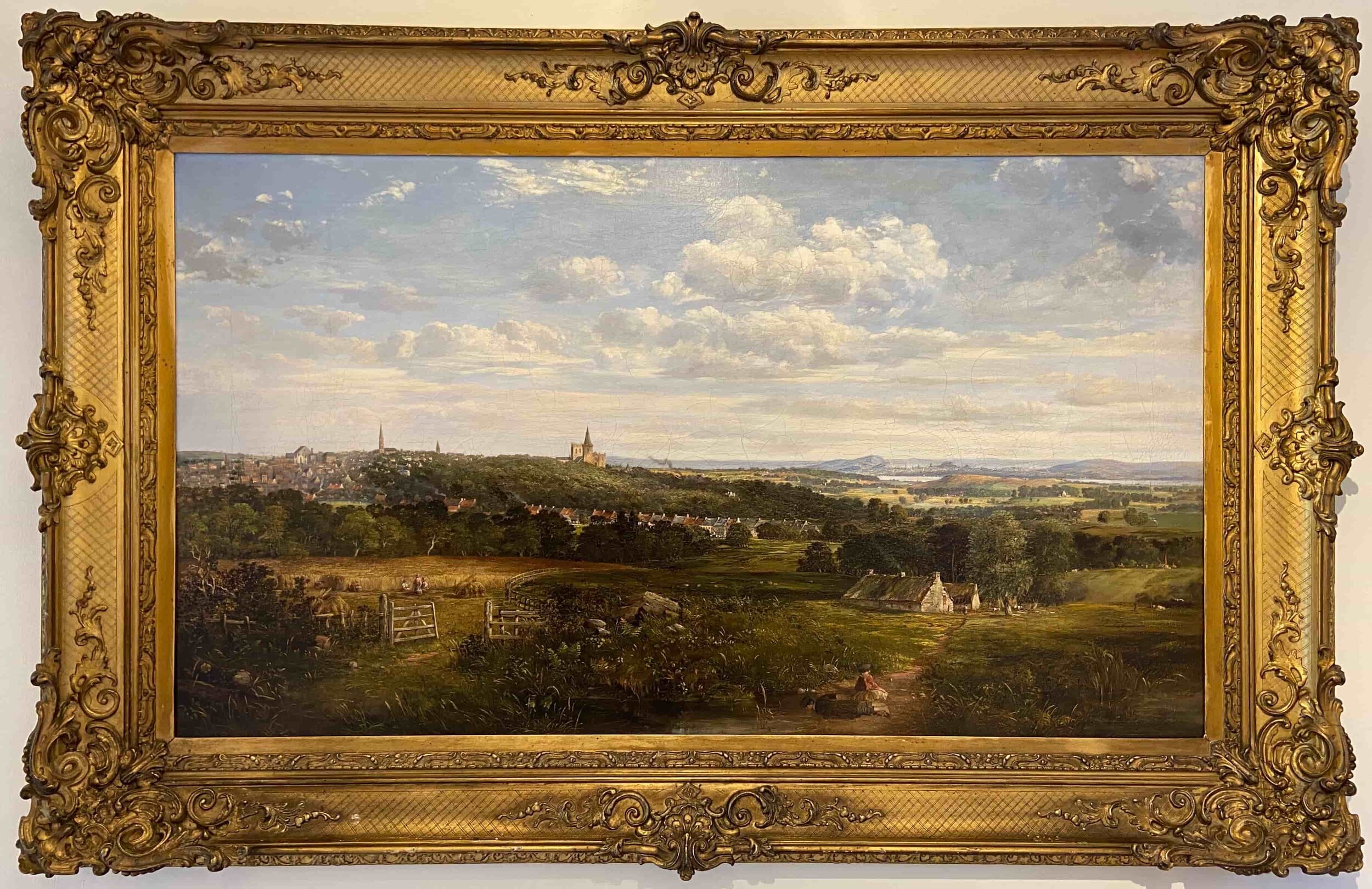This artwork, painted by local artist Andrew Blair in 1860, hangs in our museum’s refreshment area (this is the route connecting the birthplace cottage to the museum hall). If you have visited our museum before, I am sure you have walked past it countless times.
The painting, titled ‘Dunfermline from the North-West’ depicts a panoramic view of Dunfermline, as seen from Berrylaw Road (near North Urquhart Farm House). At first glance, the painting is dominated by greenery - an idyllic rural scene, with children playing by a burn, a group of women making hay and trees of Pittencrieff Estate (now Pittencrieff Park) blanketing the town. However, look more closely and this painting has many other stories to tell. Let’s have a closer look!
By the time this painting was created, handloom weaving industry, once so prominent in Dunfermline, had become obsolete. To the left of the town centre, amongst the sea of houses, a group of chimneys can be seen blowing smoke into the sky (1). These probably belong to the Dunfermline Foundry and Pilmuir Works (a linen factory founded in 1849). At the time, there were 200 power looms at Pilmuir Works (located between Pilmuir Street and Foundry Street), making it the second largest factory in town after the St Leonard’s Works in Bothwell Street (now the apartment building near ASDA St Leonard’s). There is another chimney rising to the right of Dunfermline Abbey - this may belong to Abbey Gardens Works (2), a linen factory which opened on St Margaret Street in September 1860 (the grounds of the factory are now a car park).
To the right of Pilmuir Works, Gillespie Memorial Church’s bright facade can be easily spotted (3). At the time this painting was painted, the church was only 10 years old, and its light stone front had not been darkened by smoke and soot yet. The church still stands and is located between Carnegie Drive and Dunfermline Bus Station. Why not try and find it on your next walk around the town?
Another prominent building which still stands on our bustling High Street is the Guildhall (now a Wetherspoon) (4). The foundation stone of the Guildhall (for association of artisans or merchants) was laid in 1807, but the guilds soon ran out of funds and the building remained unfinished until 1816 when it was bought by a local merchant. As a young boy in town, Andrew Carnegie would have known that building as the Spire Inn and Hotel. By 1860 the building had been sold and was used as a court house and police station.
Other buildings which would have been well-known to Andrew Carnegie are Dunfermline Abbey (5) and Pittencrieff House (6, only it’s rooftop can be seen), the owner of which had several falling-outs with the Carnegie and Morrison families. If you do not remember this story, it may be worth visiting our museum again!
A barely noticeable yet significant detail in the painting is the steam train, heading away from the town, not to Edinburgh (the Dunfermline-Edinburgh railway line didn’t open until 1877), but to Charlestown (7).
This was the route Andrew Carnegie and his family took to start their migration to America in 1848. Carnegie recalled this journey in his autobiography:
“I remember that I stood with tearful eyes looking out of the window until Dunfermline vanished from view, the last structure to fade being the grand and sacred old Abbey. During my first fourteen years of absence my thought was almost daily, as it was that morning, "When shall I see you again?" Few days passed in which I did not see in my mind's eye the talismanic letters on the Abbey tower—"King Robert The Bruce." All my recollections of childhood, all I knew of fairyland, clustered around the old Abbey and its curfew bell, which tolled at eight o'clock every evening and was the signal for me to run to bed before it stopped”.
I hope you enjoyed this little glimpse of 1860s Dunfermline. Do stop and have a closer look at the painting when you’re next visiting the museum.
By Kirke Kook, Museum Curator and Manager
(Based on Bert McEwan’s book Dunfermline Our Heritage)














